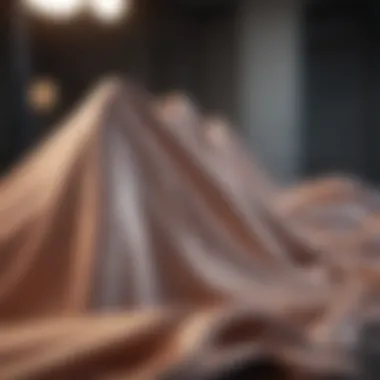Essential Guide to Cleaning Silk Clothes at Home


Intro
Silk garments exude elegance and sophistication, making them cherished pieces in many wardrobes. However, the delicate nature of silk requires a meticulous approach when it comes to cleaning and maintaining these luxuries. While you may think that the best option is to send your silk clothes to the dry cleaners, there are practical solutions for cleaning them at home without compromising their beauty.
This article aims to equip you with essential guidelines and techniques that can enhance the longevity of your silk attire. Whether you are dealing with routine maintenance or unexpected stains, readers will discover effective methods tailored for silk's unique properties. Through thoughtful care, you can keep your prized silk items looking fresh and vibrant for years to come.
Understanding Silk Fabric
Understanding silk fabric is fundamental when it comes to cleaning and maintaining silk garments. Silk is a natural protein fiber produced by silkworms. Its delicate nature requires a careful approach in care and cleaning. Knowing the intricacies of silk helps in selecting the right methods, ensuring the longevity and beauty of the fabric.
What is Silk?
Silk is a luxurious fabric, known for its smooth texture and natural sheen. It is woven from the strands of the silkworm cocoon. The production of silk dates back thousands of years, with its origins in ancient China. The process of harvesting silk involves carefully unraveling the cocoons, which is both a delicate and labor-intensive task. Silk can be classified into various types, such as Mulberry, Tussah, and Muga, each differing in texture, color, and strength. Understanding the source and properties of silk aids in tailoring the cleaning methods specific to the type of fabric you own.
Characteristics of Silk
Silk possesses unique characteristics that set it apart from other fabrics. It is lightweight yet durable, providing a favorable balance between comfort and longevity. The natural fibers allow the material to breathe, making it excellent for different climates. Additionally, silk has a natural luster, providing an elegant appearance for clothing worn in various settings, from casual to formal. However, these characteristics also mean silk is susceptible to damage. Notably, it can be impacted by direct sunlight, heat, and harsh chemicals in cleaning products. Keeping these characteristics in mind is crucial in ensuring the proper care of silk garments, allowing them to retain their luxurious appeal for a long time.
Preparation Before Cleaning
Preparing to clean silk garments is not merely a preliminary step; it is a critical process that can influence the fabric's longevity and overall appearance. Silk is a delicate material, and improper handling can lead to irreversible damage. Taking time to prepare ensures that you approach the cleaning process with the right knowledge and materials. This section outlines what you need to do before cleaning your silk clothing.
Check Care Labels
Before proceeding with any cleaning method, it is essential to read the care labels on your silk garments. These labels provide specific instructions tailored to the type of silk and any treatments the fabric may have undergone. Ignoring this vital information could lead to issues such as shrinkage, fading, or even complete ruin of the garment. Typical indications you might find include:
- Recommended cleaning methods (e.g., hand wash, professional clean)
- Suitable water temperatures
- Detergent recommendations
- Warnings against certain practices, such as using bleach
Following these guidelines helps ensure that you maintain the fabric’s natural beauty and durability, giving your silk clothes the care they deserve.
Assessing the Fabric Condition
Before starting the cleaning process, take some time to assess the condition of your silk fabric. This evaluation helps you determine the best approach to take. Inspect the garment for any damages such as tears, loose threads, or previous stains that may need special attention. Consider the following aspects:
- Visual Check: Look for discoloration, fading, or signs of wear.
- Feel: Gently run your fingers over the fabric to detect any rough areas, stiffness, or potential weakening.
- Stains: Identify any stains that are present, as different types of stains may require different removal techniques.
Understanding the fabric's state is crucial. If you identify significant damage or tough stains, it may save you time and effort to consult a professional cleaner rather than attempting home care methods. Always remember, a careful assessment sets the foundation for successful silk cleaning, preserving its elegance and richness.
General Cleaning Techniques for Silk
Cleaning silk garments involves specific techniques that ensure the fabric remains in excellent condition. Understanding the appropriate methods is crucial to maintain the beauty and longevity of silk. Each method, whether hand washing or machine washing, has its advantages and disadvantages. By following the right cleaning techniques, you can prevent damage and minimize the risk of discoloration or wear.
Hand Washing vs. Machine Washing
When it comes to cleaning silk, hand washing is often preferred due to the delicate nature of the fabric. Hand washing allows for more control over the cleaning process and reduces the risk of damaging the fibers. It is ideal for silk that is particularly delicate or has embellishments. Immerse the garment in cool water and gently agitate it. Avoid scrubbing or twisting, as this can alter the silk’s texture.
On the other hand, some silk garments are labeled as machine washable. If choosing this option, it is essential to use a gentle cycle, such as the delicate or wool cycle. Place the silk item in a mesh laundry bag to reduce the risk of snagging. Add a mild detergent specifically designed for silk. This method is efficient, but caution is necessary to ensure the fabric retains its quality.
Water Temperature Considerations


Water temperature plays a critical role in cleaning silk. Using hot water can cause silk to shrink or lose its softness. Ideally, always use cool or lukewarm water when washing silk items. If the fabric is heavily soiled, consider soaking it in cool water for a short period before applying any cleaning solution.
To ensure that the silk maintains its sheen and color, it’s essential to avoid sudden temperature changes. For instance, do not transfer a hot garment directly to cold water, as this can create stress on the fibers leading to potential tearing or fading.
Choosing the Right Detergent
Silk requires a special type of care, including the choice of detergent. Common laundry detergents may contain harsh chemicals that can damage silk fibers or strip color.
Opt for products labeled as gentle or silk-specific. Brands like Eucalan and The Laundress offer detergents specially formulated for delicate fabrics. Always follow the recommended dosage on the label, as using too much detergent can leave residues that may be difficult to rinse out. Ideally, the detergent should be pH-neutral to prevent potential harm to the silk’s appearance and texture.
It's crucial to select a detergent made for silk to maintain the integrity of the fabric and its colors.
By understanding the key differences between hand washing and machine washing, recognizing the importance of appropriate water temperature, and selecting the right detergent, you can effectively clean and preserve your silk garments. This knowledge empowers you to take better care of your precious silk clothing, keeping it looking fresh and beautiful.
Step-by-Step Silk Washing Guide
Cleaning silk clothing requires a meticulous approach to maintain its luxurious appearance and texture. This section emphasizes the necessity of following detailed steps to achieve optimal cleaning results without compromising the integrity of the fabric. Each phase, from preparing the cleaning solution to effective rinsing, is crucial in protecting the natural sheen and softness of silk. Adhering to these steps allows you to extend the lifespan of your favorite silk garments, ensuring they remain pristine for occasions long to come.
Preparing the Cleaning Solution
Before initiating any washing process, it is vital to prepare an appropriate cleaning solution. Use cool or lukewarm water mixed with a suitable detergent specially designed for delicate fabrics. It is essential to avoid using bleach or harsh chemicals as these can irreparably damage silk fibers.
- Choose a mild detergent: Look for products like Woolite or designs that clearly state they are safe for silk.
- Mix the solution: Use a basin or tub filled with water and add a few drops of the detergent. Stir gently to create a uniform solution.
- Test the solution: Before washing the entire garment, it is wise to conduct a patch test on a hidden part of the fabric to ensure it does not react negatively.
Washing Process
The washing process for silk requires careful handling. If you decide to hand wash, do so with gentle movements to avoid causing friction that might weaken the fibers. Here’s how:
- Submerge the garment: Place your silk item in the prepared solution and allow it to soak for about 5 minutes.
- Gently agitate: Lightly press and release the fabric to ensure it absorbs the sudsy solution. Avoid scrubbing or twisting the garment as this may lead to distortion.
- Duration: Limit the washing time to no more than 10 minutes. This prevents silk from losing its natural luster.
Rinsing Techniques
After washing, rinsing is equally important. This step removes detergent residue and further cleanses the fabric.
- Use cool water: Rinse the garment in cool, clean water. This helps to preserve the color and texture of the silk.
- Avoid wringing: Do not wring out the silk. Instead, gently lift the item from the water and let it drain.
- Final rinse: For an added touch of care, consider adding a small amount of white vinegar to the final rinse water. This can help to restore sheen and remove any lingering detergent traces.
"Proper rinsing is crucial for maintaining silk's delicate beauty. Take your time with this step to ensure no soap remains."
Drying Silk Garments Safely
Successfully drying silk garments is crucial in maintaining their integrity and appearance. Improper drying methods can lead to fabric damage, loss of sheen, and altered fit. Since silk is a delicate material requiring special care, ensuring silk garments dry correctly preserves their luxurious feel and look.
Benefits of Proper Drying
Drying silk safely offers numerous advantages:
- Preservation of Fabric Quality: Adequate drying ensures the fibers remain intact, reducing the risk of fraying or weakening.
- Maintaining Appearance: A proper drying method helps to keep the lustrous finish that silk is known for, avoiding dullness.
- Preventing Shrinkage: If a silk garment is dried improperly, it may shrink, potentially altering the fit permanently.
Air Drying Methods
Air drying is the most recommended technique for silk garments. Here are a few effective methods:


- Lay Flat Drying: Place the garment on a clean, dry towel that absorbs moisture well. Smooth out any wrinkles gently. This method helps maintain the shape of the garment.
- Hanging to Dry: If you opt to hang the garment, use a padded hanger to prevent marks or dimples on the fabric. Ensure that the hanger is positioned in a place away from direct sunlight, preventing fading.
- Drying Rack Use: A collapsible drying rack can also work well. Lay the silk piece flat on the rack, ensuring enough space for air to circulate around it.
Avoiding Heat Exposure
Heat can be detrimental to silk. Here are key points to avoid any heat damage:
- No Direct Heat: Never place silk garments in direct sunlight, as UV rays can cause fading and weaken the fibers. Similarly, avoid using drying machines, as they apply high heat that can lead to shrinkage or distort the garment's shape.
- Keep Away from Any Heating Devices: Ensure silk clothing is kept away from radiators, heaters, or any other heat-emitting equipment. Proximity to these units can create uneven drying and permanent damage.
- Optimal Room Temperature: Dry silk in a well-ventilated, cool area. This will facilitate even drying while preventing the risks associated with heat.
Proper drying methods contribute significantly to the longevity of silk garments, ensuring they look pristine wear after wear.
By prioritizing air drying and avoiding heat exposure, individuals can effectively care for their silk garments, maintaining their elegance and prolonging their lifespan.
Dealing with Stains on Silk
Cleaning silk requires specific attention to prevent damage to the fabric. Among the challenges faced while maintaining silk garments, stain removal is one of the most critical. Stains can occur due to a variety of substances, from food and drink spills to accidental contact with oils or cosmetics. Addressing these stains promptly is essential to preserve the aesthetic appeal and longevity of silk.
Identifying the type of stain is the first step in the cleaning process. Each type of stain may necessitate a different approach to ensure effective removal. For instance, protein-based stains, such as those from milk or sweat, require different treatment methods when compared to oil-based stains from grease or cosmetics. Understanding the nature of the stain you are dealing with can help you choose the appropriate removal method.
Identifying the Type of Stain
Identifying the type of stain is crucial for effective treatment. Here are several common stain categories and their characteristics:
- Protein-Based Stains: These include stains from foods like eggs, dairy, or perspiration. They often require cold water for treatment to avoid setting the stain.
- Oil-Based Stains: Such stains come from oily foods or cosmetics. They typically require gentle degreasers for removal.
- Dye Stains: These can be from colored drinks or other colored substances. They often need specialized stain removers to lift them effectively.
To start, you should assess the stain's origin and the fabric's reaction to water. Always conduct a patch test on a hidden area of the garment to check if the textiles remain intact.
Pro Tip: The quicker you act on a stain, the better your chance of removing it without damage.
Stain Removal Techniques
Once you identify the stain type, you can employ specific removal techniques:
- For Protein-Based Stains:
- For Oil-Based Stains:
- For Dye Stains:
- Rinse the area with cold water immediately. Avoid hot water as it can set the stain.
- Apply a small amount of liquid detergent and gently work it through the fabric.
- Rinse thoroughly with cold water until all detergent is removed.
- Sprinkle baking soda or cornstarch on the stain to absorb excess oil. Allow it to sit for about 15 minutes.
- Gently brush off the powder and treat the area with a gentle dish soap mixed with water.
- Blot the stain carefully with a clean cloth dampened with water. Do not rub, as this may spread the dye further.
- Use a store-bought dye remover specifically designed for silk or a homemade mixture of vinegar and water, ensuring it is suitable for silk.
Each treatment method emphasizes gentleness to maintain the integrity of the silk. Always refer to the care labels of your garments and proceed with caution.
Ironing and Storing Silk Clothes
Maintaining silk garments goes beyond cleaning. Ironing and proper storage are critical aspects that can influence the longevity and overall appearance of silk clothing. Understanding how to iron silk properly ensures that the fabric retains its beauty without damage. Similarly, storing silk in a suitable manner can prevent creasing, fading, or other forms of wear.
Ironing Recommendations
When it comes to ironing silk, the process must be approached with caution. Here are some recommendations to handle this delicate fabric effectively:


- Use a Low Heat Setting: Always set your iron to a low heat to avoid scorching the silk fibers. The ideal temperature usually falls between 120-140 degrees Celsius.
- Use a Pressing Cloth: A thin cotton cloth or a silk organza can be used as a barrier between the iron and the silk. This protects the fabric from direct heat and minimizes the risk of burns.
- Iron While Slightly Damp: It is recommended to iron silk while it is slightly damp. Lightly spritzing the fabric with water can help create steam and ease out creases. Avoid soaking.
- Iron on the Reverse Side: This technique helps to protect the front of the garment from potential shine or markings caused by the iron.
- Move Quickly: Do not keep the iron stationary. Gliding it smoothly helps in reducing the risk of damaging the fabric.
"Caring for the delicate nature of silk will preserve its luxurious appearance over time."
Following these tips can significantly improve the final look of your silk attire, making it ready for any occasion.
Proper Storage Practices
Proper storage is essential for maintaining the quality of silk clothes. Here are a few approaches that will help to keep your garments in excellent condition:
- Use Breathable Garment Bags: If you need to store silk for a long time, opt for breathable fabric garment bags. Plastic can trap moisture and lead to mold or mildew.
- Avoid Hangers with Clips: When hanging silk garments, use padded or satin hangers instead of those with clips that may leave impressions or cause stretching.
- Keep Away from Direct Sunlight: Storing silk in a dark, dry place is preferred. Sunlight can fade the color and weaken the fabric over time.
- Fold Carefully: If placing silk into drawers or boxes, fold them carefully to avoid sharp creases. Place tissue paper between layers for additional protection.
- Regularly Air Out: Even in storage, it is wise to occasionally remove the garments to air them out. This practice helps to prevent mustiness.
Noticing these details can vastly improve the durability and aesthetic quality of silk clothing. Paying attention to both ironing and storage practices is integral to preserving the elegance that silk is known for.
Professional Dry Cleaning: When to Consider It
Dry cleaning silk garments can be an important option for maintaining the beauty and longevity of the fabric. Silk is inherently delicate, and specific situations may warrant professional intervention rather than tackling the cleaning at home. This section will delve into why professional dry cleaning can be essential, highlighting the benefits and considerations of this method:
- Expertise in Handling Delicate Fabrics: Professional dry cleaners possess the experience necessary to handle silk effectively. They understand the intricacies of varying silk types and can choose the appropriate methods and solvents to ensure that the fabric's integrity is not compromised.
- Specialized Cleaning Techniques: Dry cleaning utilizes solvents instead of water, which can prevent damage that might occur with excessive moisture. This is particularly relevant if a garment contains intricate detailing, such as beading or embroidery, which may become distorted during regular washing processes.
- Stain Treatment Pre-Dry Cleaning: In cases of particularly stubborn stains, professionals often use pre-treatment solutions tailored for silk before the actual cleaning. This step can significantly enhance the chances of successful stain removal without harming the fabric.
- Restoration of Luster: Silk has a natural sheen that can fade over time. Professional cleaning can restore the vibrancy and softness of silk garments, something that might not happen with home cleaning techniques.
"Investing in professional dry cleaning can extend the life of your silk clothing significantly, ensuring these garments retain their elegance for years to come."
When Home Cleaning is Insufficient
Home cleaning may not always yield the results expected when dealing with silk. Several factors dictate the need to seek professional services:
- Severe Stains: If your silk item is stained with substances like oil, red wine, or ink, attempting to clean it at home may worsen the situation. Home remedies might not be effective and can even set the stain.
- Fabric Damage: Upon noticing loose threads, fading colors, or fabric puckering, it is advisable to proceed with caution. These signs indicate that the fabric is stressed, requiring professional assessment rather than home care.
- Complicated Cleaning Needs: Some silk garments, especially those with pleats, layers, or linings, present challenges that are best handled by experts. Ensuring these elements are treated properly without cause damage should be a priority.
Finding a Reliable Cleaner
Selecting a trustworthy dry cleaner is crucial for the proper care of silk garments. Here are some key factors to consider:
- Research and Reviews: Look for cleaners with positive reviews, especially ones specializing in delicate fabrics. Online platforms like Reddit can provide insights into customer experiences.
- Certification and Experience: Ensure that the dry cleaner has certifications or shows evidence of significant experience with silk and similar fabrics. This expertise often translates to better care.
- Ask About Techniques: Inquire about the methods the cleaner uses, including their approach to stain removal. A transparent discussion about their practices can help in assessing their professionalism.
- Service Guarantees: A reliable cleaner often provides guarantees for their services, ensuring that they will take responsibility if any issues arise during the cleaning process.
The importance of professional dry cleaning cannot be overstated when it comes to preserving silk garments. Taking these pointers into account can make a significant difference in maintaining the quality and appearance of your delicate silk items.
Maintaining Silk Over Time
Maintaining silk garments is crucial for longevity and the overall appearance of the fabric. Silk is known for its elegance and luxurious feel, but it is also delicate. Proper care can significantly extend the life of silk items, preserving both their texture and sheen. When silk is neglected, it can lose its luster, develop stains, and become susceptible to damage. Thus, understanding how to care for silk clothes is paramount.
Regular Care Practices
Implementing regular care practices can make a significant difference in the maintenance of silk clothing. Here are some key routines:
- Gentle Washing: Always opt for gentle washing methods, either hand washing or using a delicate cycle on the washing machine. Use a mild detergent specifically designed for silk or delicate fabrics.
- Frequent Brushing: Lightly brushing silk clothes with a soft clothing brush helps to remove any accumulated dust or particles.
- Spot Cleaning: For minor stains, spot cleaning is effective. Use a damp cloth to gently dab the stained area instead of rubbing it.
- Avoid Storing in Direct Sunlight: UV rays can fade the color of silk over time. Store silk in a cool, dry place, away from direct sunlight.
These practices not only keep the fabric looking fresh but also help in detecting any small issues before they become major problems.
Identifying Wear and Tear
It's important to regularly inspect silk garments for signs of wear and tear. Early detection can prevent further damage and save costs in repairs. Key things to look for include:
- Fading Colors: If the colors on the fabric look washed out, this can indicate damage from light exposure or incorrect washing.
- Fraying Edges: Pay attention to seams and hems. Frayed edges are a sign that the fabric is wearing down and needs repair.
- Pilling: Small balls of fiber that form on the surface of silk can indicate that the garment is nearing the end of its life.
- Weak Areas: Regular wear and tear can compromise certain areas, particularly underarms and hems. Check for areas that might feel thin or stretched.
Regular inspections and maintenance can help preserve your silk investments and keep them looking new.



